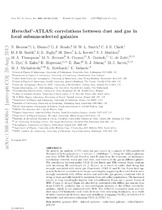| dc.contributor.author | Dunne, L. | |
| dc.contributor.author | Bourne, N. | |
| dc.contributor.author | Bendo, G.J. | |
| dc.contributor.author | Smith, M.W.L. | |
| dc.contributor.author | Clark, C.J.R. | |
| dc.contributor.author | Smith, Daniel J.B. | |
| dc.contributor.author | Rigby, E.E. | |
| dc.contributor.author | Baes, M. | |
| dc.contributor.author | Leeuw, L.L. | |
| dc.contributor.author | Maddox, S.J. | |
| dc.contributor.author | Thompson, M.A. | |
| dc.contributor.author | Bremer, M.N. | |
| dc.contributor.author | Cooray, Asantha | |
| dc.contributor.author | Dariush, A. | |
| dc.contributor.author | de Zotti, G. | |
| dc.contributor.author | Dye, S. | |
| dc.contributor.author | Eales, S. | |
| dc.contributor.author | Hopwood, R. | |
| dc.contributor.author | Ibar, Edo | |
| dc.contributor.author | Ivison, R.J. | |
| dc.contributor.author | Jarvis, Matt | |
| dc.contributor.author | Michalowski, M.J. | |
| dc.contributor.author | Rowlands, K. | |
| dc.contributor.author | Valiante, E. | |
| dc.date.accessioned | 2016-02-16T20:33:03Z | |
| dc.date.available | 2016-02-16T20:33:03Z | |
| dc.date.issued | 2013 | |
| dc.identifier.citation | Bourne, N., et al. (2013). Herschel*-ATLAS: correlations between dust and gas in local submm-selected galaxies. Monthly Notices of the Royal Astronomical Society, 436 (1): 479-502. | |
| dc.identifier.issn | 0035-8711 | |
| dc.identifier.uri | http://hdl.handle.net/10566/2075 | |
| dc.description.abstract | We present an analysis of CO molecular gas tracers in a sample of 500
μ
m-selected
Herschel
-ATLAS galaxies at
z <
0
.
05 (
cz <
14990 km s
−
1
). Using 22
−
500
μ
m photom-
etry from
WISE
,
IRAS
and
Herschel
, with H
i
data from the literature, we investigate
correlations between warm and cold dust, and tracers of the gas in
different phases.
The correlation between global CO(3–2) line fluxes and FIR–submm fl
uxes weakens
with increasing IR wavelength (
λ
&
60
μ
m), as a result of colder dust being less
strongly associated with dense gas. Conversely, CO(2–1) and H
i
line fluxes both ap-
pear to be better correlated with longer wavelengths, suggesting
that cold dust is more
strongly associated with diffuse atomic and molecular gas phases, co
nsistent with it
being at least partially heated by radiation from old stellar populations
. The increased
scatter at long wavelengths implies that sub-millimetre fluxes are a po
orer tracer of
SFR. Fluxes at 22 and 60
μ
m are also better correlated with diffuse gas tracers than
dense CO(3–2), probably due to very-small-grain emission in the diffu
se interstellar
medium, which is not correlated with SFR. The FIR/CO luminosity ratio a
nd the
dust mass/CO luminosity ratio both decrease with increasing luminosit
y, as a result
of either correlations between mass and metallicity (changing CO/H
2
) or between CO
luminosity and excitation [changing CO(3–2)/CO(1–0)]. | |
| dc.rights | © 2013 The Authors. Published by Oxford University Press on behalf of the Royal Astronomical Society. This is the author version of the article accepted for publication in the Monthly Notices of the Royal Astronomical Society. The published version of this article is available at https://mnras.oxfordjournals.org/content/436/1/479. | |
| dc.source.uri | http://dx.doi.org/v10.1093/mnras/stt1584 | |
| dc.subject | Interstellar medium (ISM) | |
| dc.subject | Radio lines | |
| dc.subject | Galaxies | |
| dc.subject | Submillimeter galaxies | |
| dc.subject | Spectral energy distribution (SED) | |
| dc.subject | Herschel | |
| dc.title | Herschel*-ATLAS: correlations between dust and gas in local submm-selected galaxies | |
| dc.description.accreditation | Web of Science | |

